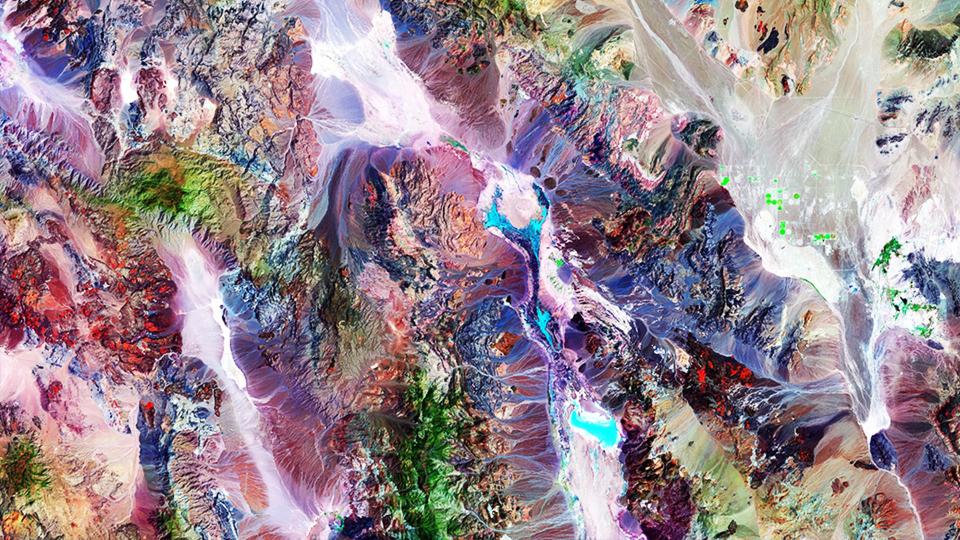While the Bear Cam bears hibernate, the Trump admin weighs a big plan to mine their world

When the peak of summer arrives in Alaska and the radiant midnight sun hangs in the northern sky, tens of millions of salmon make their move. They race up rivers, leap over waterfalls, and clog narrow streams with their hefty, five-pound bodies. It is then that Alaska's Bristol Bay — home to the largest run of sockeye salmon on the planet — comes to life. Wolverines, foxes, lynx, and bald eagles descend upon this untrammeled realm. And the most dominant creature of the land, the brown bear, saunters down to these rivers. It's here that the bears grow fat, stripping the skin off of salmon like it's string cheese and devouring the pink flesh and fatty brains.
"For the bears that live in Bristol Bay, the salmon are basically everything," said Mike Fitz, an ecologist and former park ranger in nearby Katmai National Park — home to the globally popular bears of the park's bear cam who reside in the Bristol Bay watershed. The salmon, after spending two or three years fattening up in the ocean, return to Alaska and provide bounties of food for bears while enriching the Alaskan ecosystem with nutrients. "Salmon affect every strand of the food web," said Fitz. "They transcend boundaries between the ocean and land in ways no other organism can."
"This is the largest remaining salmon population in the world," said Carl Safina, an ecologist at Stony Brook University. "It’s a precious, humanly-valued, and indefinitely sustainable resource that is heavily relied upon by people." Indeed, in the summer of 2018, over 62 million sockeye salmon returned to Bristol Bay — millions of which were caught by the region's flourishing fishing industry. It was the bay's largest-ever recorded run of salmon.
But unease now looms over the region. This winter, the Trump administration restarted an environmental review that might allow a Canadian mining company, Northern Dynasty, to bore into the ground at the Bristol Bay headwaters — the source of the bay's rivers — in pursuit of copper and gold. Such an unprecedented project, called the Pebble Mine, would dig up 73 million tons of material each year, bringing the risk of lasting change — and possibly irreversible harm — to this salmon-dominated wilderness.
"How does helping this underfunded Canadian company make America great again?" asked Joel Reynolds, Western Director and Senior Attorney at the Natural Resources Defense Council (NRDC).
"It is absolutely preposterous," added Reynolds, who flew over the remote, proposed mining site in 2018.
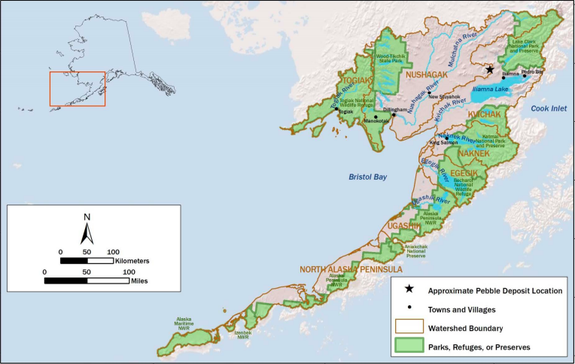
Image: epa
The idea of a Pebble Mine isn't new. The Obama administration's Environmental Protection Agency (EPA) scrutinized the project, concluding that the mine "could result in significant and unacceptable adverse effects on ecologically important streams, wetlands, lakes, and ponds and the fishery areas they support," and placed a slew of restrictions on the project. The mine's prospects looked dismal as investors fled. "All the money had left the project," said Reynolds. "The project was on the verge of going away."
But now it's back. "The Trump administration threw that project a lifeline," said Reynolds, referencing the reopening an environmental assessment. "There's no question about it."
In 2017, CNN reported that then-EPA chief Scott Pruitt — known for disseminating climate-denialist talking points to his staff — met with Pebble Mine brass to discuss the project. Following the meeting, the EPA confirmed that Pruitt had allowed the environmental review to proceed.
Now, the ball is rolling. The Army Corps of Engineers, one of the federal agencies tasked with approving the Pebble Mine's permit, released the initial draft of an Environmental Impact Statement (EIS) on February 20. Following possible revisions after the public weighs in, the Trump administration will use this report to decide whether or not the environmental impacts of the project are acceptable. There's a significant amount of environmental risk to consider, as the isolated project essentially requires building infrastructure for a town: two water treatment plants to discharge mined water into the Bristol Bay's streams, a 188-mile-long natural gas pipeline to power the mine, pits for mud-like mining waste (known as tailings), a roadway for trucking, and a new port to unload mined materials onto ships. Any member of the U.S. public has 90 days to read and respond to the draft.
SEE ALSO: Will cockroaches really inherit the Earth?
While the NRDC is not inherently opposed to the technological necessities of mining in the 21st century ("The world needs minerals — that's why mining exists," said Reynolds) and demand for copper is expected to increase over the next 30 years, the consensus among diverse parties is that this land — the pure Bristol Bay watershed and its teeming natural bounty — simply should not be gambled on a temporary 20-year mine.
"It's the wrong mine in the wrong place," said Norm Van Vactor, president of the Bristol Bay Economic Development Corporation.
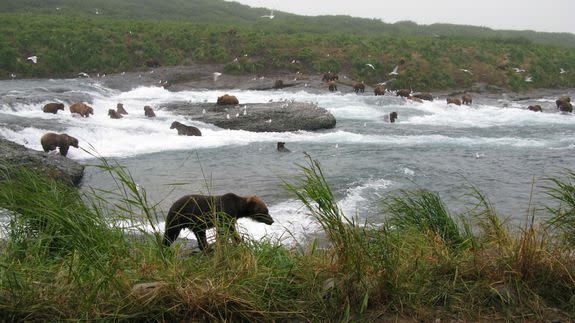
Image: drewhh / wikimedia commons
The Gamble
Although Bristol Bay has seen exceptional salmon runs over the past several years — which in 2018 left the Bear Cam bears with a surplus of these 4,500-calorie sacks of nutrients — there are periods of terrific runs followed by grimmer years. It's the natural course of things.
The bad years will inevitably come again, said Van Vactor, a Bristol Bay resident. That's all the reason not to gamble on Bristol Bay's health, he said. "Why on top of that [bad years] would we want to risk really screwing this thing up?" asked Van Vactor.
"At the end of the day, do we really want to risk what is truly one of mother nature's wonders of the world for copper and gold? I don’t think we do," he added.
The famous and rotund Bear Cam bears of Katmai National Park inhabit the greater realms of the Bristol Bay watershed, but there are other salmon and brown bear populations living in and around the headwaters zone that would experience a much more significant impact from any pernicious threat from mining (like elevated levels of heavy metals in the water), or a more sudden disaster (like a breach of mining waste). Still, many Katmai bears, who migrate in and out of the park's invisible boundaries, would almost certainly be impacted by the far-reaching mine's roads, construction, and development in the region, noted Fitz.
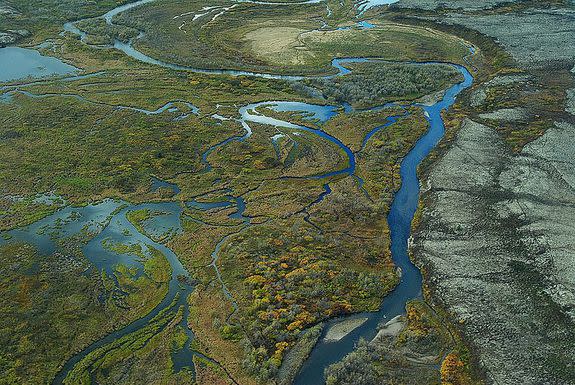
Image: Epa
Northern Dynasty, who represents itself through an organization called the Pebble Partnership, maintains that the project will not damage the Bristol Bay watershed, nor the rich fisheries Alaskans rely on.
"We will coexist with the other industries," said Mike Heatwole, the Vice President of Public Affairs at the Pebble Partnership.
Heatwole added that the company has worked with "very experienced fish biologists" to ensure the mine could operate without harming Bristol Bay's natural resources. That means no "population-level challenges to fish and wildlife resources," he explained.
Reynolds isn't so sure. "That’s what they have to say to be allowed to move forward in Bristol Bay," he said. "They'll say it even if it isn't true."
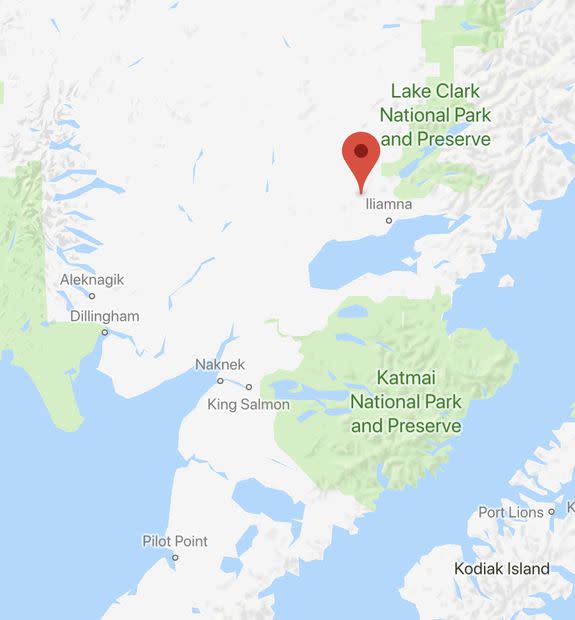
Image: nps
There's no question that Pebble Mine will need to satisfy a slew of both federal and state regulations for the treated water they discharge into the ecosystem, air quality standards, and plans to close everything down when they've mined all the copper. But these regulations won't guarantee the continued vibrancy of Bristol Bay, long after the mine shutters for good.
"At the end of the day it's death by 1,000 cuts," said Van Vactor, noting how the incremental rise of development inside sensitive river habitats stoked the collapse of the salmon fishery on the U.S. West Coast.
"It didn't happen accidentally," added Van Vactor.
"It's almost like people in the Lower 48 have this generational amnesia," said Fitz, describing the destruction of the Pacific Northwest fisheries. "We don't realize what it was once like. It used to be flooded with fish."
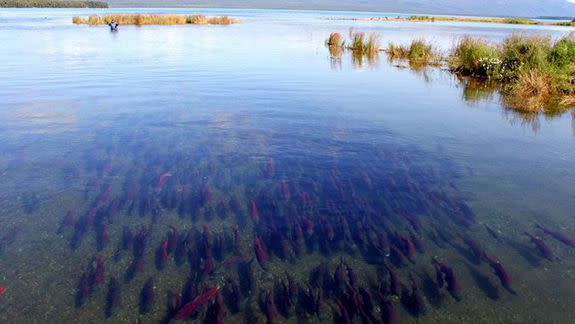
Image: Katmai National Park
Though the Pebble Mine is just one development, Fitz emphasizes that this is how all the nation's most infamous environmental degradations began. "You can see it across the history of wildlife mismanagement across North America," said Fitz, which has also resulted in still devastated populations of grizzly bears and wolves. "It's those incremental steps that end up devastating salmon runs."
The disappearance of salmon is also evident on the East Coast. "Hardly any Atlantic salmon come back to New England," noted Fitz.
"It can happen to Bristol Bay, too," he said.
The decline of wilderness and wildlife in the lower 48 states leaves places like Bristol Bay as a particularly valued resource. It's a largely undeveloped world whose profusion of life is nearly unparalleled. The untrammeled region is the rare instance of nature in the 21st century reaching its maximum promise. "It's potential is fully realized," said Fitz. A single industrial development here — notably one requiring extensive infrastructure — would be all the more visible. To ecologists and biologists, the Pebble Mine would exist as a glaring gouge with a host of threats.
"It is the single most important land-use decision in North America in our lifetimes, and certainly one of the most important decisions in the world," said Safina.
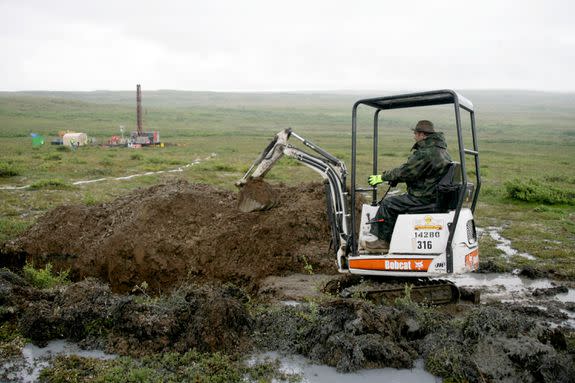
Image: Al Grillo/AP/REX/Shutterstock
For many of Bristol Bay residents, like Van Vactor, threats to their resource are all the more frustrating because the Trump Administration has only given the community 90 days to read an Environmental Impact Statement (EIS) that's hundreds of pages long, before responding to it.
"It's all about trying to fast-track this thing, shove it down our throats, and move on," Van Vactor said.
The EIS is rife with missing data and damning realities, said the NRDC senior counsel, Reynolds. The document acknowledges a permanent loss of 3,458 acres of wetlands and other waters along with 73.2 miles of streams, he said. But that's not all.
"The EIS fails to consider worst-case scenarios for the project, relies on untested and unrealistic claims about water treatment, and fails to address the economic feasibility of the project," said Reynolds.
When the 90-day comment period closes and the federal government begins assessing the public's concerns, the region's brown bears will have just started waking from their six-month winter slumber. It marks the renewal of an environmental battle that ecologists thought was buried. But it's been resurrected.
"This is one of those monsters that’s hard to kill," said Safina. "You think it’s dead, but then it comes back in a sequel."
WATCH: 20 incredible views of U.S. national parks from space – Space Is Weird
